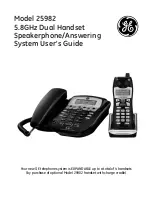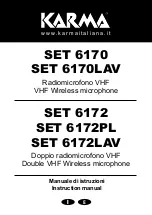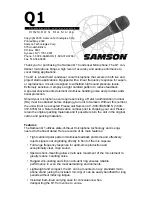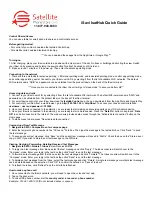
7
8.2. Checking Ambient Signal Condition
8.2.1. What is the "squelch"?
In FM receivers, such as a wireless tuner, big noise is produced at the output when incoming signals are weak
or when no signal is present. When the signal received is lower than a certain level of signal strength, by
silencing the output, the noise can be suppressed. It is a squelch circuit that achieves this. An RF check
button is provided to permit check of a disturbing wave when the unit is interfered with during its use. The key
also checks the presence of the disturbing wave in the channel of the new channel numbers when the unit is
set for such numbers.
8.2.2. Operation
Hold down the RF check button for a while. As long as this button is pressed, the wireless tuner outputs the
condition received in the highest sensitivity, allowing an operator to hear radio interference.
Note
Take care about the volume level since noise or interfering sounds are heard while the key is pressed.
8.3. Reducing Radio Interference by the Squelch Control
Squelch Control Graduation
0
1
2
3
4
5
6
Transmission Distance (%)
100
85
70
50
30
20
15
Squelch control
The WT-5810 tuner has the squelch function that virtually eliminates ambient noise and unwanted other
wireless microphone systems by silencing the output when the signal received is lower than a certain level of
signal strength.
This signal strength level can be varied by means of the squelch control. The sensitivity is the highest and
radio signals can be received in wide areas when the control is in the "fully counterclockwise" position, while
the "fully clockwise" position makes the sensitivity the lowest, permitting the radio signals to be only received
in narrow areas.
It is possible to eliminate disturbing waves and only receive the radio signal transmitted from the required
microphone by changing the squelch setting to make the radio signal reception area narrow. The wireless
microphone's signal transmission distance varies largely depending on its ambient conditions.
The table below provides the guideline on the squelch control vs. transmission
distance ratio, supposing that the squelch control is graduated from "0" to "6"
as illustrated though not actually so.
Note:
Transmission distance is a relative ratio with respect to 100% at "0" level.
Tips
• Set the control to the "0" position in locations free from interference.
• Set the control to the position that does not cause any reception loss of wireless microphone signals.
Squelch control
0
SQ
6


























